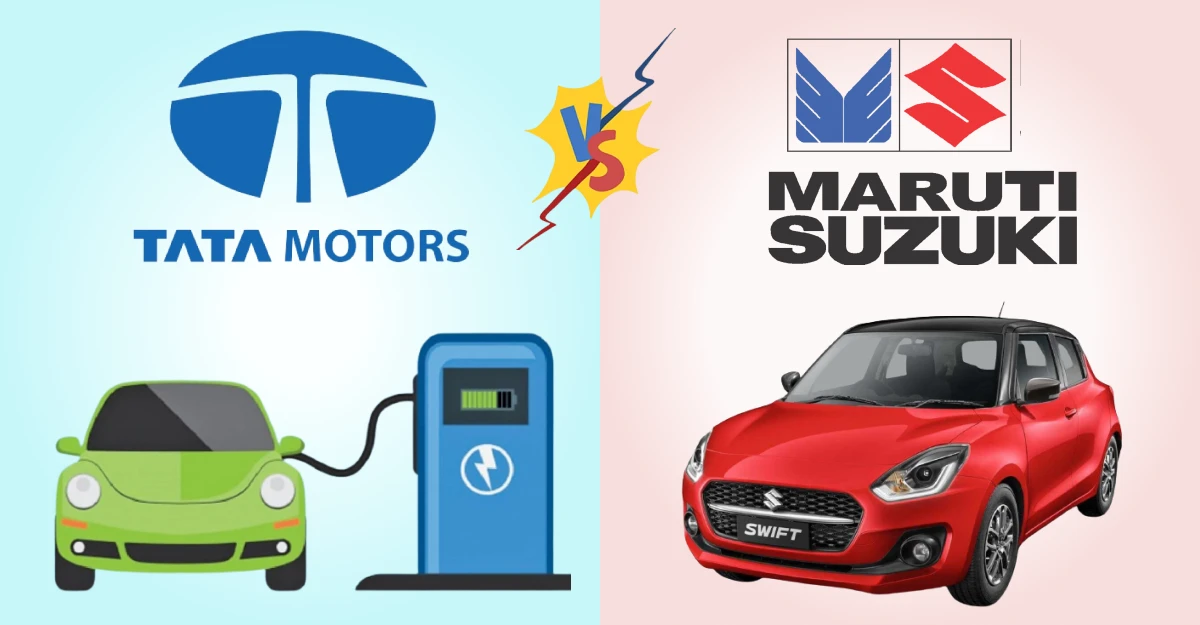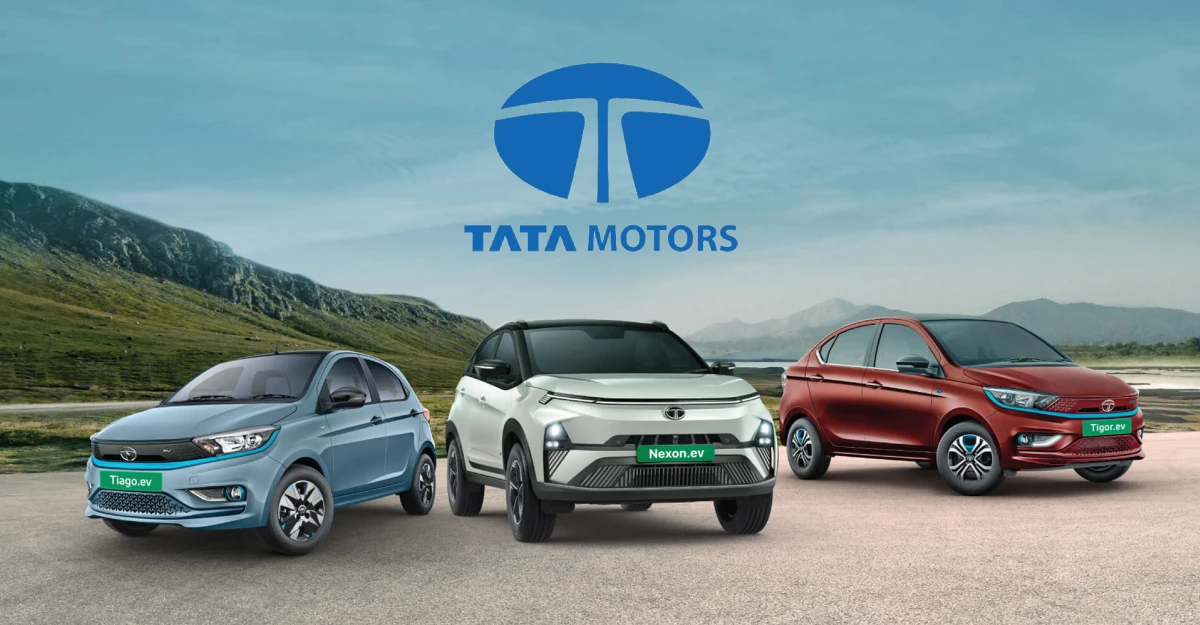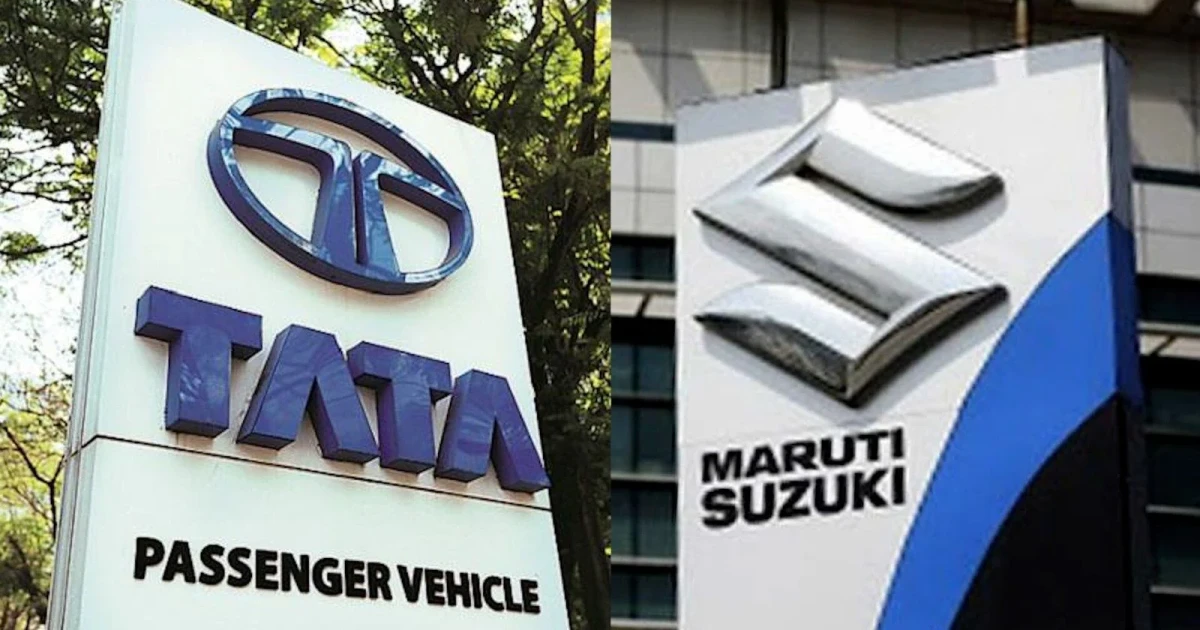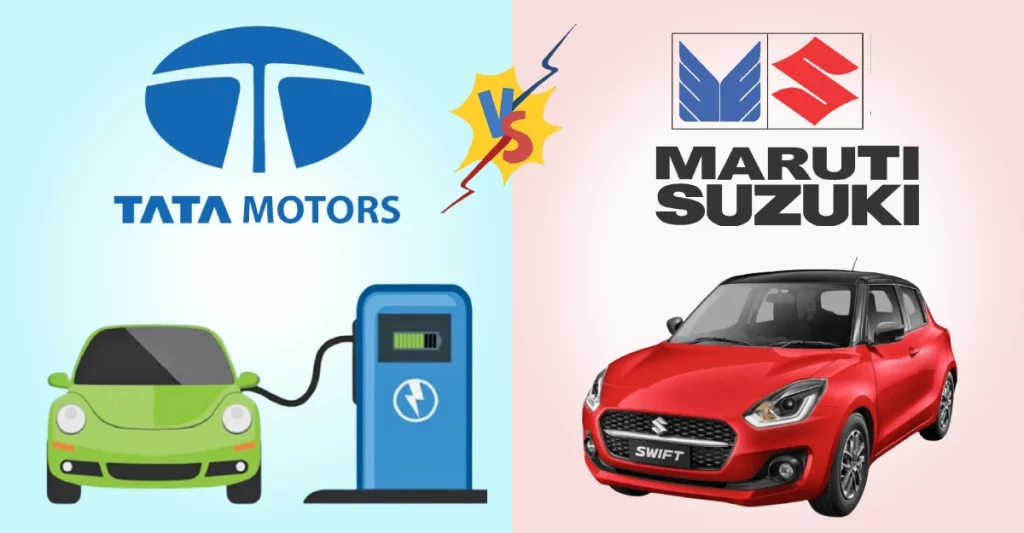Experts say that soon, we won’t have to rely on fossil fuels for vehicles because EVs will rule the automobile market! Currently, Tata Motors is the leading EV company with a whopping market share of 72%. Surprisingly, this fact doesn’t make Tata Motors the king of four-wheelers. Why? You may ask.
Maruti Suzuki wears the crown of passenger vehicles with a market share of 41.5% whereas Tata Motors lags with a market share of 13.9%. Another mind-blowing fact is Maruti Suzuki hasn’t entered the electric car market yet.

Now, here comes a million-dollar question- Can Tata Motors surpass Maruti Suzuki with the help of EVs?
Let’s find out!
(A) Tata Motors Struggle Story: From Survival to Revival
First of all, look at the following stats of passenger vehicle market share (%) based on sales-
| Automobile Company | Tata Motors | Maruti Suzuki |
| Year 2013-14 | 5.5% | 42.1% |
| Year 2022-23 | 13.9% | 42.5% |
Can you see the difference? Although Maruti Suzuki has been a reigning king in the Passenger vehicle market since the last decade. But the massive improvement made by Tata Motors to grab the market share catches our attention more! From merely 5.5% to 13.9% market share wasn’t a cakewalk.
Back then Tata Motors was struggling to survive with its iconic yet old models like Indica, Indigo, and Nano. Nano’s failure was no less than a black spot for Tata Motors.
Tata Motors realized that the old models wouldn’t work anymore. They need to innovate and manufacture new models to become a market leader.
Hence, they invested heavily in research and development. And Voila! In the year 2020, Tata Motors hit the purple patch with an entirely new portfolio-
- Tiago
- Nexon SUV
- Altroz (Premium Car)
- Harrier (Big SUV)
- Safari (Seven Seated Premium Car with a price tag of Rs.25 lakh)
- Punch (“Micro” SUV)
Do you know, that Tiago, Nexon, and Tigor were launched with their electric versions too? And those were superhit in the market.
This new portfolio was responsible for the exponential growth trajectory of Tata Motors. Its market share climbed to 13.9% with over 5,00,000 unit sales in the domestic market.
Wait, there’s more!
In the Auto Expo (a biennial automotive show) held in Greater Noida, NCR, India; Tata Motors displayed a range of new cars viz.-
- Avinya (Electric SUV)
- Curvv (SUV)
- EV version of Harrier
- EV version of Sierra
After years of heavy losses, Tata Motors posted remarkable financial growth in FY24. Here’s how-
| Financials of Tata Motors | Amount |
| Revenue | Rs.437,000 crore |
| EBITDA (Earnings before Interest, Taxes, Depreciation, and Amortization) | Rs.62,800 crore |
| PBT (Profit Before Taxes) | Rs.28,900 crore |
| Net Profit | Rs.31,800 crore |
That’s how India’s most valuable carmaker i.e. Tata Motors reported a significant increase in net profit driven by the strong performance of its automobile business!
(B) Is the new Portfolio of Tata Motors enough to compete with Maruti Suzuki?

Despite launching so many different models, Tata Motors’ portfolio is quite small as compared to Maruti. The latter has countless models. With the current portfolio, Tata Motors addresses only 55% of the passenger vehicle market.
Their target is to increase the number to 75%.
Moreover, Tata Motors doesn’t have a model equivalent to the Maruti Alto. How does it matter? You may wonder. Look, the Maruti Alto possesses 7% of our passenger vehicle market. Undoubtedly, you always see Maruti Alto on the road wherever you are!
After all, this “mini car” priced between Rs.3.5-4 lakh has been a favorite of most of the Indians. Also, the Maruti Wagon R still holds the crown of “largest selling car” for two decades.
You know what, Tata has no intention to manufacture lower-priced cars anymore. It doesn’t want to repeat the Nano failure. This time, it is highly focused on premium cars. Why? Because that’s what catches the eyes of most of the Indians in the current decade.
Experts say that Maruti Cars are famous for their affordable prices and not for their quality. This is the point where Tata Motors will shoot its arrow to compete with Maruti Suzuki.
Soon the tables will turn and the new portfolio of Tata Motors will be able to beat Maruti Suzuki. How?
Go through the next section, and you’ll find out.
(C) Tata Motors Plans to surpass Maruti Suzuki

Challenging the dominant position held by Maruti in the Indian passenger vehicle market is quite an uphill battle.
So, one solution to this was to boost the Tata Motors dealerships aggressively. So yes, it did so and doubled its sales network with over 1,400 dealerships in 2023. You see it is a lot higher than the fiscal year 2016 with 589 dealerships. They pipped (beaten) Hyundai which has 1,333 dealerships in 2023.
But Maruti is much ahead with over 3,209 dealerships in FY23.
Since this solution didn’t work out as expected. Therefore, the panacea (one cure for all ill) for surpassing Maruti was to fight with EVs!
(D) Tata Motors’ EV Strategy: Aiming to Overtake Maruti Suzuki

How Tata Motors is planning to surpass Maruti Suzuki with the help of EVs? You may wonder. The company has a detailed and ambitious plan that focuses on significant investment, market development, and leveraging its early start in the EV sector. Here’s how Tata Motors plans to achieve this goal-
(D.1) Massive Investment in EVs
Tata Motors is committing over Rs.16,000 crore to its EV ventures by the end of this decade. This is substantially more than Maruti Suzuki’s Rs.10,440 crore and Hyundai’s Rs.4,000 crore investment plans. Such a hefty investment signals Tata Motors’ serious intent to lead the EV revolution in India.
(D.2) Early Entry and Massive EV Portfolio
While Maruti Suzuki and Hyundai are yet to launch their mass-market EVs, expected around 2023-24, Tata Motors already has a head start. By the time their competitors launch their first EVs, Tata Motors plans to have five different EV models on the road. This early entry allows Tata Motors to refine its products and understand the market better.
(D.3) Learning from Experience
Tata Motors’ electric cars have collectively clocked over 600 million kilometers on Indian roads. This extensive real-world experience provides valuable insights into vehicle performance and consumer preferences. This knowledge gives Tata Motors a significant advantage over latecomers, who will need to go through a similar learning curve.
(D.4) Building EV Infrastructure
A critical part of Tata Motors’ strategy is improving the EV ecosystem. The company is working with charge point operators to establish around 22,000 charging stations across the country. This network will make owning and operating an EV more convenient, addressing one of the main barriers to EV adoption.
(D.5) Promoting Solar Rooftop Integration
To make EVs more economically attractive, Tata Motors is collaborating with solar rooftop companies. By promoting solar power integration, the company aims to reduce the overall cost of ownership for EV owners. This initiative will not only make EVs more viable but also promote sustainable energy solutions.
Note: We have explained this part in the article “What Is The Rooftop Solar Scheme & Government Plans With It?” You can go through it for detailed information.
(D.6) Expanding Market Presence
Tata Motors is confident in its ability to exceed sales targets. Despite missing the goal of 100,000 units in FY24, the company remains optimistic about surpassing this figure in the current year. This confidence stems from their robust EV portfolio and the expanding market demand for electric vehicles.
(D.7) Addressing Barriers to EV Adoption
Tata Motors is actively working on various fronts to ease the transition to EVs for consumers. This includes the following-
- Total Cost of Ownership (TCO): Ensuring that EVs are cost-effective over their lifetime.
- Model Variety: Offering a range of models to meet different consumer needs.
- Use Cases: Catering to various applications and preferences.
(D.8) Learning from Market Trends
Historically, Tata Motors has seen segments it created later dominated by other brands, like Maruti’s Swift in the premium hatchback segment and Hyundai’s Creta in the midsize SUV segment. However, in the sub-four-metre SUV segment, Tata’s Nexon has emerged dominant. These experiences have shaped Tata Motors’ strategy to maintain its lead in the EV market by continuously innovating and expanding its portfolio.
(E) Future Perspective: The Road Ahead
Surely it looks like Tata Motors is working really hard to set the pitch for the EV game. But guess what? Maruti doesn’t seem to be worried about its future!
A senior executive at Maruti Suzuki is confident that their company will eventually lead the electric vehicle (EV) market. They believe Tata Motors is currently doing the hard work by setting up charging stations and educating people about EVs, and they think the major shift towards EVs is still a few years away.
Maruti plans to enter the market strongly when the time is right!
However, with its significant investment, early start, and proactive market development, Tata Motors is well-positioned to maintain its lead. By addressing key barriers and expanding its infrastructure, Tata Motors aims to create a robust EV ecosystem that could help it surpass Maruti Suzuki in the coming years.
The competition between Tata Motors and Maruti Suzuki is ongoing, and it will be interesting to see which company emerges as the leader in India’s EV market in the coming years!


Iss Tata going to be the Tesla of India?? I would love to see it 😁